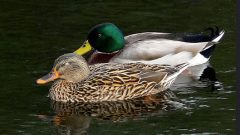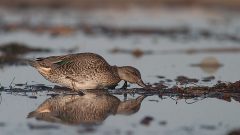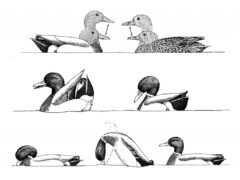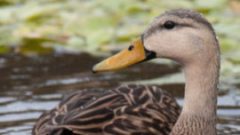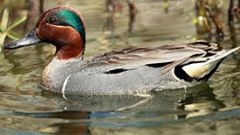Mallard Photo Gallery
Breeding male
Breeding male has iridescent green head, yellow bill, white collar around neck, brown breast, and a grayish body.
© Christoph Moning / Macaulay LibraryBayern, November 03, 2012Female
Female is mottled brown, with an orange-and-black bill.
© Joshua Vandermeulen / Macaulay LibraryOntario, December 10, 2008Breeding male
Common on ponds, lakes, and streams. Males have glossy green head, white ring on neck, brown chest, and yellow bill.
© Eric Liner / Macaulay LibraryNew York, February 09, 2012Not all videos have soundBreeding male
In flight, note male's black-and-white tail and blue wing patch bordered by two white bars.
© Cynthia King / Macaulay LibraryNew York, November 27, 2020Immature male
A strong flier that can reach speeds of 55 miles per hour.
© Mason Maron / Macaulay LibraryWashington, May 18, 2020Female
Feeds in shallow water on aquatic invertebrates and vegetation. Does not dive.
© Benjamin Clock / Macaulay LibraryNew York, September 14, 2011Not all videos have soundNonbreeding male
Nonbreeding male is browner, like a female, but retains its black-and-white tail and often shows at least a trace of green on the head.
© Christoph Moning / Macaulay LibraryBayern, August 18, 2013Nonbreeding male and female
Mallards shed all their flight feathers at the end of the breeding season and are flightless for 3–4 weeks. They are secretive during this vulnerable time, and their body feathers molt into a concealing “eclipse” plumage that can make them hard to identify.
© Linda Lewis / Macaulay LibraryMaryland, August 16, 2016Breeding male and female
Courtship involves many displays, including synchronized head-bobbing and the female swimming toward the male with her head held low in the water.
© Timothy Barksdale / Macaulay LibraryMontana, February 01, 2001Not all videos have soundFemale and chick
Newly hatched ducklings are covered in down and ready to leave the nest within 13–16 hours.
© Bruce Gates / Macaulay LibraryOntario, August 01, 2016Breeding male
At home on the ground as well as in the water.
© Herb Elliott / Macaulay LibraryCalifornia, February 09, 2018Breeding males and female
Feeds in shallow water by tipping up to reach submerged vegetation. Does not dive.
© Matthew D. Medler / Macaulay LibraryNew York, November 28, 2014Not all videos have soundBreeding male and female
Most pairs form in the fall or early winter, well before the start of actual breeding.
© Jonathan Irons / Macaulay LibraryVirginia, November 02, 2019Breeding male and female
Found in almost any wetland habitat, including marshes, lakes, ponds, roadside ditches, pastures, and rice fields.
© Christopher Shell / Macaulay LibraryCalifornia, February 08, 2016Male (hybrid with American Black Duck)
Frequently hybridizes with American Black Duck. Male hybrid has only partial green head and is darker overall than male Mallard.
© Michael O'Brien / Macaulay LibraryNew Jersey, February 05, 2017Compare with Similar Species
Click on an image to compare
Species in This Family
Ducks, Geese, and Waterfowl(Order: Anseriformes, Family: Anatidae)



















































